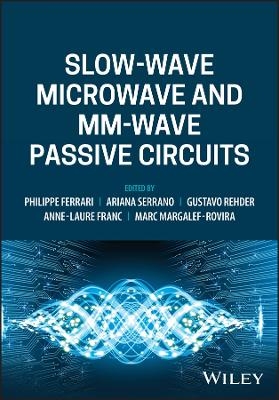
Slow-wave Microwave and mm-wave Passive Circuits
Seiten
2024
John Wiley & Sons Inc (Verlag)
978-1-119-82016-1 (ISBN)
John Wiley & Sons Inc (Verlag)
978-1-119-82016-1 (ISBN)
Comprehensive resource presenting the fundamentals and state of the art concepts, design examples, relevant components, and technology
Slow-wave Microwave and mm-wave Passive Circuits presents the fundamentals and state of the art concepts, design examples, relevant components, and technology of the subject, plus examples of circuit layout optimization using slow-wave circuits. Recent advances in aspects of the slow-wave concept are covered, with potential applications including automotive radars, medical and security applications, and 5G and future 6G for very high-speed communications.
The text considers a variety of slow-wave structures and associated concepts which are useful for circuit design, each structure electrically modeled with clear illustration.
The highly qualified authors show that the use of the slow-wave concept can, in some cases, improve the performance of passive circuits. The techniques proposed make it possible to reduce the size and/or the performance of the circuits, with a beneficial cost-saving effect on semiconductor materials. Concepts are applied to several technologies, namely CMOS, PCB (Printed Circuit Board) and nanowires.
Sample topics covered include:
Concepts of energy storage with examples of slow-wave CPW (S-CPW), slow-wave SIW (SW-SIW), and slow-wave microstrip (S-MS),
Transmission line topology and application in integrated technologies (CMOS), including possibilities offered by the BEOL (Back-End-Of-Line),
Effect of the geometrical dimensions on the transmission line parameters (Zc, α, εreff, and Q) and comparisons between conventional CPW and CPS, and slow-wave CPW and CPS,
Performance of slow-wave coupled lines and comparison with conventional microstrip coupled lines.
Slow-wave Microwave and mm-wave Passive Circuits is a highly useful resource for graduate students (best complemented with a basic book on microwaves), engineers, and researchers. The text is also valuable for physicists wishing to implement comparable techniques in optics or mechanics.
Slow-wave Microwave and mm-wave Passive Circuits presents the fundamentals and state of the art concepts, design examples, relevant components, and technology of the subject, plus examples of circuit layout optimization using slow-wave circuits. Recent advances in aspects of the slow-wave concept are covered, with potential applications including automotive radars, medical and security applications, and 5G and future 6G for very high-speed communications.
The text considers a variety of slow-wave structures and associated concepts which are useful for circuit design, each structure electrically modeled with clear illustration.
The highly qualified authors show that the use of the slow-wave concept can, in some cases, improve the performance of passive circuits. The techniques proposed make it possible to reduce the size and/or the performance of the circuits, with a beneficial cost-saving effect on semiconductor materials. Concepts are applied to several technologies, namely CMOS, PCB (Printed Circuit Board) and nanowires.
Sample topics covered include:
Concepts of energy storage with examples of slow-wave CPW (S-CPW), slow-wave SIW (SW-SIW), and slow-wave microstrip (S-MS),
Transmission line topology and application in integrated technologies (CMOS), including possibilities offered by the BEOL (Back-End-Of-Line),
Effect of the geometrical dimensions on the transmission line parameters (Zc, α, εreff, and Q) and comparisons between conventional CPW and CPS, and slow-wave CPW and CPS,
Performance of slow-wave coupled lines and comparison with conventional microstrip coupled lines.
Slow-wave Microwave and mm-wave Passive Circuits is a highly useful resource for graduate students (best complemented with a basic book on microwaves), engineers, and researchers. The text is also valuable for physicists wishing to implement comparable techniques in optics or mechanics.
Philippe Ferrari, Professor of Electrical Engineering, University Grenoble Alpes, France and senior member of the IEEE. Anne-Laure Franc, Assistant Professor with the University of Toulouse, France. Marc Margalef-Rovira, Research Engineer at STMicroelectronics, France. Gustavo P. Rehder, Associate Professor, Department of Electronic Systems at the Laboratory of Microelectronics, University of São Paulo, Brazil. Ariana Lacorte Caniato Serrano, Associate Assistant Professor of Electrical Engineering, Department of Electronic Systems, University of São Paulo, Brazil.
| Erscheint lt. Verlag | 5.12.2024 |
|---|---|
| Verlagsort | New York |
| Sprache | englisch |
| Maße | 170 x 244 mm |
| Gewicht | 510 g |
| Themenwelt | Technik ► Elektrotechnik / Energietechnik |
| ISBN-10 | 1-119-82016-2 / 1119820162 |
| ISBN-13 | 978-1-119-82016-1 / 9781119820161 |
| Zustand | Neuware |
| Haben Sie eine Frage zum Produkt? |
Mehr entdecken
aus dem Bereich
aus dem Bereich
Technologie – Berechnung – Klimaschutz
Buch | Hardcover (2023)
Hanser (Verlag)
39,99 €


